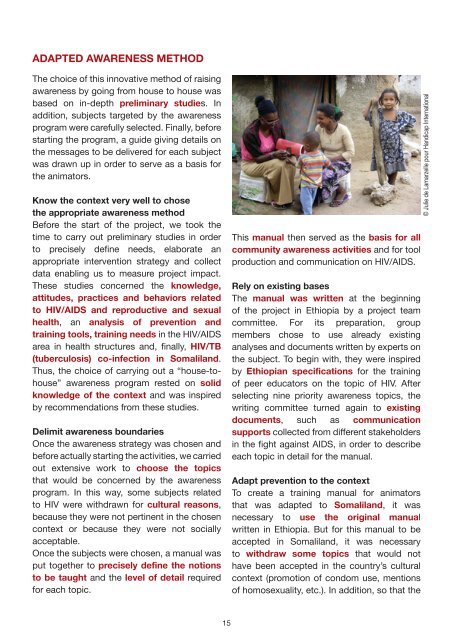Anchoring Awareness in the Community - Handicap International
Anchoring Awareness in the Community - Handicap International
Anchoring Awareness in the Community - Handicap International
You also want an ePaper? Increase the reach of your titles
YUMPU automatically turns print PDFs into web optimized ePapers that Google loves.
ADAPTED AWARENESS METHOD<br />
The choice of this <strong>in</strong>novative method of rais<strong>in</strong>g<br />
awareness by go<strong>in</strong>g from house to house was<br />
based on <strong>in</strong>-depth prelim<strong>in</strong>ary studies. In<br />
addition, subjects targeted by <strong>the</strong> awareness<br />
program were carefully selected. F<strong>in</strong>ally, before<br />
start<strong>in</strong>g <strong>the</strong> program, a guide giv<strong>in</strong>g details on<br />
<strong>the</strong> messages to be delivered for each subject<br />
was drawn up <strong>in</strong> order to serve as a basis for<br />
<strong>the</strong> animators.<br />
Know <strong>the</strong> context very well to chose<br />
<strong>the</strong> appropriate awareness method<br />
Before <strong>the</strong> start of <strong>the</strong> project, we took <strong>the</strong><br />
time to carry out prelim<strong>in</strong>ary studies <strong>in</strong> order<br />
to precisely def<strong>in</strong>e needs, elaborate an<br />
appropriate <strong>in</strong>tervention strategy and collect<br />
data enabl<strong>in</strong>g us to measure project impact.<br />
These studies concerned <strong>the</strong> knowledge,<br />
attitudes, practices and behaviors related<br />
to HIV/AIDS and reproductive and sexual<br />
health, an analysis of prevention and<br />
tra<strong>in</strong><strong>in</strong>g tools, tra<strong>in</strong><strong>in</strong>g needs <strong>in</strong> <strong>the</strong> HIV/AIDS<br />
area <strong>in</strong> health structures and, f<strong>in</strong>ally, HIV/TB<br />
(tuberculosis) co-<strong>in</strong>fection <strong>in</strong> Somaliland.<br />
Thus, <strong>the</strong> choice of carry<strong>in</strong>g out a “house-tohouse”<br />
awareness program rested on solid<br />
knowledge of <strong>the</strong> context and was <strong>in</strong>spired<br />
by recommendations from <strong>the</strong>se studies.<br />
Delimit awareness boundaries<br />
Once <strong>the</strong> awareness strategy was chosen and<br />
before actually start<strong>in</strong>g <strong>the</strong> activities, we carried<br />
out extensive work to choose <strong>the</strong> topics<br />
that would be concerned by <strong>the</strong> awareness<br />
program. In this way, some subjects related<br />
to HIV were withdrawn for cultural reasons,<br />
because <strong>the</strong>y were not pert<strong>in</strong>ent <strong>in</strong> <strong>the</strong> chosen<br />
context or because <strong>the</strong>y were not socially<br />
acceptable.<br />
Once <strong>the</strong> subjects were chosen, a manual was<br />
put toge<strong>the</strong>r to precisely def<strong>in</strong>e <strong>the</strong> notions<br />
to be taught and <strong>the</strong> level of detail required<br />
for each topic.<br />
This manual <strong>the</strong>n served as <strong>the</strong> basis for all<br />
community awareness activities and for tool<br />
production and communication on HIV/AIDS.<br />
Rely on exist<strong>in</strong>g bases<br />
The manual was written at <strong>the</strong> beg<strong>in</strong>n<strong>in</strong>g<br />
of <strong>the</strong> project <strong>in</strong> Ethiopia by a project team<br />
committee. For its preparation, group<br />
members chose to use already exist<strong>in</strong>g<br />
analyses and documents written by experts on<br />
<strong>the</strong> subject. To beg<strong>in</strong> with, <strong>the</strong>y were <strong>in</strong>spired<br />
by Ethiopian specifications for <strong>the</strong> tra<strong>in</strong><strong>in</strong>g<br />
of peer educators on <strong>the</strong> topic of HIV. After<br />
select<strong>in</strong>g n<strong>in</strong>e priority awareness topics, <strong>the</strong><br />
writ<strong>in</strong>g committee turned aga<strong>in</strong> to exist<strong>in</strong>g<br />
documents, such as communication<br />
supports collected from different stakeholders<br />
<strong>in</strong> <strong>the</strong> fight aga<strong>in</strong>st AIDS, <strong>in</strong> order to describe<br />
each topic <strong>in</strong> detail for <strong>the</strong> manual.<br />
Adapt prevention to <strong>the</strong> context<br />
To create a tra<strong>in</strong><strong>in</strong>g manual for animators<br />
that was adapted to Somaliland, it was<br />
necessary to use <strong>the</strong> orig<strong>in</strong>al manual<br />
written <strong>in</strong> Ethiopia. But for this manual to be<br />
accepted <strong>in</strong> Somaliland, it was necessary<br />
to withdraw some topics that would not<br />
have been accepted <strong>in</strong> <strong>the</strong> country’s cultural<br />
context (promotion of condom use, mentions<br />
of homosexuality, etc.). In addition, so that <strong>the</strong><br />
© Julie de Lamarzelle pour <strong>Handicap</strong> <strong>International</strong><br />
15

















